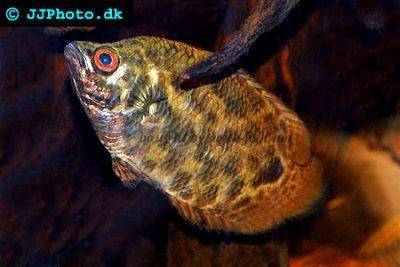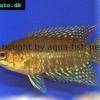Spotted ctenopoma - Ctenopoma acutirostre
Scientific name: Ctenopoma acutirostre
Common name: Spotted ctenopoma
Family: Anabantidae
Usual size in fish tanks: 12 - 15 cm (4.72 - 5.91 inch)
014
Recommended pH range: 6 - 7.5
Recommended water hardness: 5 - 12°N (89.29 - 214.29ppm)
0°C 32°F30°C 86°F
Recommended temperature range: 23 - 28 °C (73.4 - 82.4°F)
The way how these fish reproduce: Spawning
Where the species comes from: Africa
Temperament to its own species: peaceful to females
Temperament toward other fish species: aggressive to smaller
Usual place in the tank: Middle levels
Overview
Ctenopoma acutirostre—commonly called the Leopard Bushfish or Spotted Ctenopoma—is a stealthy, leaf-mimicking predator from the Congo Basin (Central Africa). Crepuscular to nocturnal by nature, it lurks among plants and wood, then lunges at passing prey. Although hardy, it requires thoughtful tankmate choices and a well-structured aquascape.
Care & Tank Setup
- Tank size: A single adult needs at least 200 l / 55 gal with a tank length of 100–120 cm. Larger systems are recommended for multiple specimens.
- Water parameters: pH 6.0–7.5, hardness 5–12 °dGH, temperature 23–28 °C (73–82 °F). Prioritize stable, clean, well-oxygenated water.
- Aquascape: Dense planting, driftwood, and rockwork to create sight-line breaks and ambush cover. Provide shaded zones; subdued lighting calms skittish behavior.
- Filtration: Robust biological filtration with moderate flow. Perform regular, sizable water changes to manage waste.
- Cover: Tight-fitting lid—bushfish can jump when startled.
Diet & Feeding
Obligate carnivore and ambush predator.
- Staples: High-quality sinking/slow-sinking carnivore pellets and sticks (once trained).
- Frozen/live: Mysis, krill, chopped prawn, earthworms, insect larvae, and occasional fish fillet.
- Avoid: Routine feeder fish (pathogens/poor nutrition) and tubifex as a staple. Offer varied, meaty foods rather than beef heart.
- Feeding style: Feed after lights dim; use tongs to target-feed in community setups.
Behavior & Compatibility
- Conspecifics: Juveniles may cohabit, but adults become territorial. Keep singly, as a formed pair, or as a larger group only in very spacious tanks with abundant cover.
- Other fish: Predatory toward small fish. Choose robust, similarly sized or larger mid-/bottom-dwellers that are not fin-nippy (e.g., larger Congo tetras, peaceful cichlids, armored catfish).
Sexing
External differences are subtle. Mature males may show slightly broader heads and more developed cranial/opercular spines (small serrations along the gill cover). Reliable sexing is difficult without close inspection.
Breeding
Not a bubble-nest builder. In very large, dimly lit aquaria with floating plants, pairs may spawn near the surface at night, releasing buoyant eggs that drift among plants. Parents do not guard; remove adults or the eggs for higher yield. Eggs typically hatch within a few days; start fry on infusoria/rotifers, then newly hatched brine shrimp.
Lifespan
Typically 8–10 years in captivity, occasionally longer with excellent care.
Origin
Central Africa: Congo River basin, in slow to moderately flowing forest streams and flooded marginal zones with heavy vegetation and cover.
Short description
An intelligent, ambush-hunting anabantid that thrives in structured, low-light tanks. Provide ample cover, a protein-rich varied diet, and compatible tankmates of adequate size.
At-a-Glance (Care Box)
- Size (captive): 12–15 cm (up to ~18 cm)
- Temperament: Territorial with conspecifics; predator of small fish
- pH: 6.0–7.5 | GH: 5–12 °dGH
- Temp: 23–28 °C (73–82 °F)
- Tank: Single adult ≥ 200 l / 55 gal; dense cover, subdued light
- Diet: Carnivore (pellets once trained; mysis, prawn, worms, insect larvae)
- Breeding: Night surface spawner; buoyant eggs; no parental care
- Lifespan: 8–10 years
Pictures
Bought by aqua-fish.net from jjphoto.dk.




 Climbing
Climbing  Congo
Congo